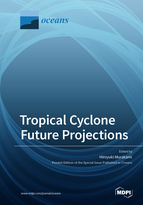Tropical Cyclone Future Projections
A special issue of Oceans (ISSN 2673-1924).
Deadline for manuscript submissions: closed (15 April 2021) | Viewed by 28420
Special Issue Editor
Interests: tropical cyclones; climate dynamics; future projections; predictions and predictability; numerical modelling
Special Issues, Collections and Topics in MDPI journals
Special Issue Information
Dear Colleagues,
The increasing frequency of tropical-cyclone damage has attracted public interest regarding the impact of global warming on tropical cyclone activity. Although the global mean temperature has been rising since the 20th century, the detection and attribution of any climate change in tropical cyclone activity remains uncertain due to the limited length of reliable observations. A number of previous studies reported projected future changes in tropical cyclone frequency. However, there still remains substantial uncertainty regarding future changes in tropical cyclone activity and its impact.
Publications in the Special Issue will aim to minimize uncertainty in the possible future changes in tropical cyclone activity. Individual papers solicited for this Special Issue shall focus on the following topics:
- Quantifying change in the characteristics of tropical cyclones in a warmer climate;
- Observed climate change in tropical cyclone activity;
- Assessing tropical cyclone risks, mitigations, and adaptations for the future climate change;
- Assessing potential future changes in impact tropical cyclones in oceans (e.g., marine biochemistry; marine ecosystem; storm surges; sea level rise);
- Theoretical or experimental study related to tropical cyclone climate.
Dr. Hiroyuki Murakami
Guest Editor
Manuscript Submission Information
Manuscripts should be submitted online at www.mdpi.com by registering and logging in to this website. Once you are registered, click here to go to the submission form. Manuscripts can be submitted until the deadline. All papers will be peer-reviewed. Accepted papers will be published continuously in the journal (as soon as accepted) and will be listed together on the special issue website. Research articles, review articles as well as short communications are invited. For planned papers, a title and short abstract (about 100 words) can be sent to the Editorial Office for announcement on this website.
Submitted manuscripts should not have been published previously, nor be under consideration for publication elsewhere (except conference proceedings papers). All manuscripts are thoroughly refereed through a single-blind peer-review process. A guide for authors and other relevant information for submission of manuscripts is available on the Instructions for Authors page. Oceans is an international peer-reviewed open access biannual journal published by MDPI.
Please visit the Instructions for Authors page before submitting a manuscript. The Article Processing Charge (APC) for publication in this open access journal is 1000 CHF (Swiss Francs). Submitted papers should be well formatted and use good English. Authors may use MDPI's English editing service prior to publication or during author revisions.






